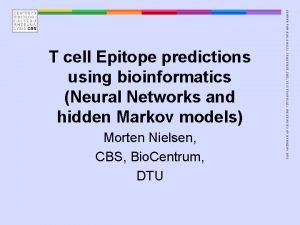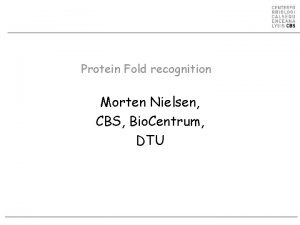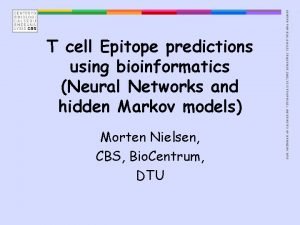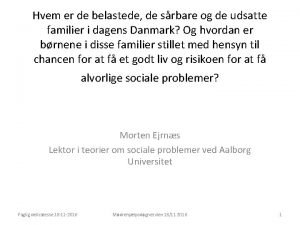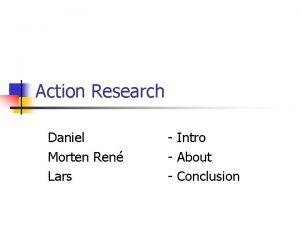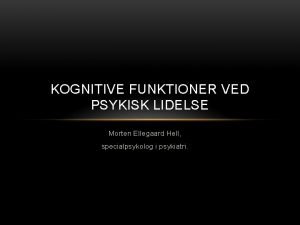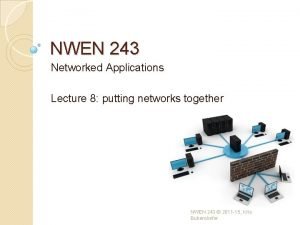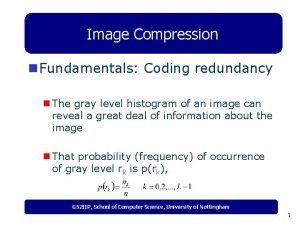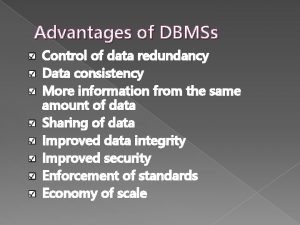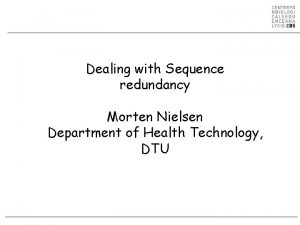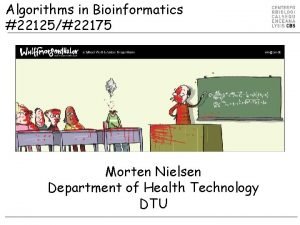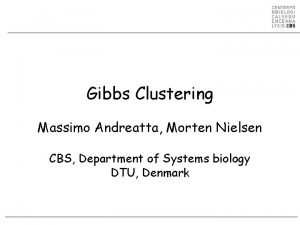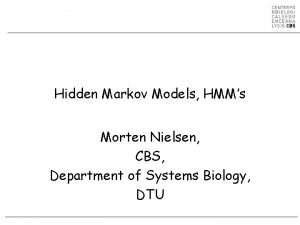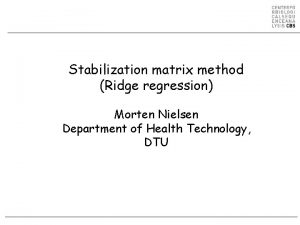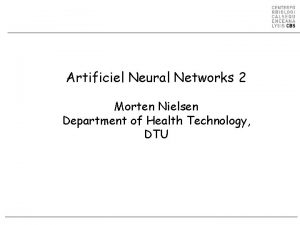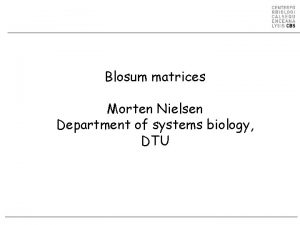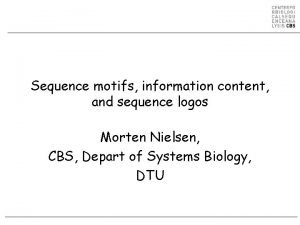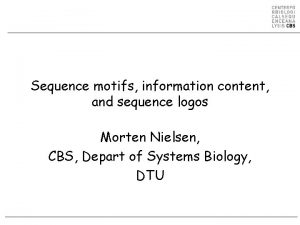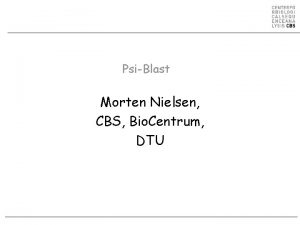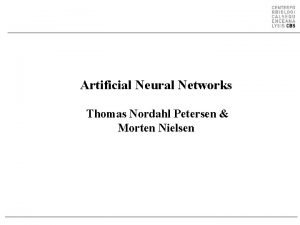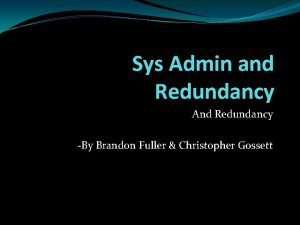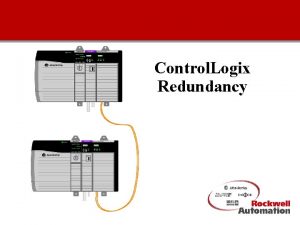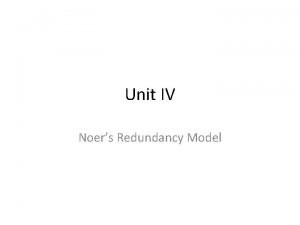Dealing with Sequence redundancy Morten Nielsen Department of


























- Slides: 26

Dealing with Sequence redundancy Morten Nielsen Department of Systems Biology, DTU

Outline • What is data redundancy? • Why is it a problem? • How can we deal with it?

Databases are redundant • Biological reasons – Some protein functions, or sequence motifs are more common than others • Laboratory artifacts – Some protein families have been heavily investigated, others not – Mutagenesis studies makes large and almost identical replica of data – This bias is non-biological

Date redundancy 10 MHC restricted peptides ALAKAAAAM ALAKAAAAN ALAKAAAAR ALAKAAAAT ALAKAAAAV GMNERPILT GILGFVFTM TLNAWVKVV KLNEPVLLL AVVPFIVSV What can we learn? 1. A at P 1 favors binding? 2. I is not allowed at P 9? 3. K at P 4 favors binding? 4. Which positions are important for binding?

Redundant data ALAKAAAAM ALAKAAAAN ALAKAAAAR ALAKAAAAT ALAKAAAAV GMNERPILT GILGFVFTM TLNAWVKVV KLNEPVLLL AVVPFIVSV

PDB. Example • 1055 protein sequence • Len 50 -2000 • 142 Function annotations – – – ACTIN-BINDING ANTIGEN COAGULATION HYDROLASE/DNA LYASE/OXIDOREDUCTASE ENDOCYTOSIS/EXOCYTOSIS –…

PDB. Example

What is similarity? • Sequence identity? ACDFG ACEFG 80% ID versus 24% ID DFLKKVPDDHLEFIPYLILGEVFPEWDERELGVGEKLLIKAVA------MATGIDAKEIEESVKDTGDL-GE DVLLGADDGSLAFVP----- SEFSISPGEKIVFKNNAGFPHNIVFDEDSIPSGVDASKISMSEEDLLNAKGE • Blast e-values – Often too conservative • Other

Ole Lund et al. (Protein engineering 1997)

Ole’s formula

How to deal with redundancy • Hobohm 1 – Fast – Requires a prior sorting of data • Hobohm 2 – Slow – Gives unique answer always – No prior sorting

Hobohm 1 Input data - sorted list Unique A B C D E F G H I Add next data point to list of unique if it is NOT similar to any of the elements already on the unique list

Hobohm 1 Input data Unique A B C D E F G H I Add next data point to list of unique if it is NOT similar to any of the elements already on the unique list

Hobohm 1 Input data Unique B C D E F G H I Add next data point to list of unique if it is NOT similar to any of the elements already on the unique list A

Hobohm 1 Input data Unique B A D C E F G I H Add next data point to list of unique if it is NOT similar to any of the elements already on the unique list Need only to align sequences against the Unique list!

Hobohm-2 • Align all against all • Make similarity matrix D (N*N) with value 1 if is similar to j, otherwise 0 • While data points have more than one neighbor – Remove data point S with most nearest neighbors

Hobohm-2 D: A B C D E F G H I A 1 1 1 0 0 0 B 1 1 1 0 0 1 1 C 1 1 1 0 0 0 D 0 0 0 1 1 1 E 0 0 0 1 1 1 F 0 0 0 1 1 1 0 0 1 G 0 0 0 1 1 1 H 0 1 1 1 I 0 1 1 1 1 Make similarity matrix N*N

Hobohm-2 D: S A B C D E F G H I A 1 1 1 0 0 0 B 1 1 1 0 0 1 1 C 1 1 1 0 0 0 D 0 0 0 1 1 1 E 0 0 0 1 1 1 F 0 0 0 1 1 1 0 0 1 G 0 0 0 1 1 1 H 0 1 1 1 I 0 1 1 1 1 N 3 5 3 6 6 4 5 6 7 Find point S with the largest number of similarities

Hobohm-2 D: A B C D E F G H I A 1 1 1 0 0 0 B 1 1 1 0 0 1 1 C 1 1 1 0 0 0 D 0 0 0 1 1 1 D: E 0 0 0 1 1 1 F 0 0 0 1 1 1 0 0 1 G 0 0 0 1 1 1 H 0 1 1 1 I 0 1 1 1 1 N 3 5 3 6 6 4 5 6 7 A B C D E F G H A 1 1 1 0 0 0 B 1 1 1 0 0 1 C 1 1 1 0 0 0 D 0 0 0 1 1 1 E 0 0 0 1 1 1 F 0 0 0 1 1 1 0 0 G 0 0 0 1 1 H 0 1 1 Remove point S with the largest number of similarities, and update N counts N 3 4 3 5 5 3 4 5

Hobohm-2 (repeat this) D: A B C D E F G H A 1 1 1 0 0 0 B 1 1 1 0 0 1 C 1 1 1 0 0 0 D 0 0 0 1 1 1 D: E 0 0 0 1 1 1 F 0 0 0 1 1 1 0 0 G 0 0 0 1 1 H 0 1 1 N 3 4 3 5 5 3 4 5 A A 1 B 1 C 1 B 1 1 1 C 1 1 1 E 0 0 0 F 0 0 0 G 0 0 0 H 0 1 0 N 3 4 3 E F G H 0 0 0 1 1 1 0 0 1 1 1 0 1 1 4 2 3 4 0 0 Remove point S with the largest number of similarities

Hobohm-2 (until N=1 for all) D: A B C D E F G H I A 1 1 1 0 0 0 B 1 1 1 0 0 1 1 C 1 1 1 0 0 0 D 0 0 0 1 1 1 D’: E 0 0 0 1 1 1 F 0 0 0 1 1 1 0 0 1 G 0 0 0 1 1 1 H 0 1 1 1 I 0 1 1 1 1 N 3 5 3 6 6 4 5 6 7 Unique list is C, F, H => C F H N C 1 0 0 1 F H 0 0 1 1 1

Hobohm

Hobohm-1

Hobohm-2

Why two algorithms? • Hobohm-2 – Unbiased – Slow (O 2) – Focuses on lonely sequences – Example from exercise • 1000 Sequences alignment 2 hours • Hobohm-2: 22 seconds • Hobohm-1 – Biased. Prioritized list – Fast (0) – Focuses on populated sequence areas – Example from exercise • 1000 Sequences • Hobohm-1: 12 seconds • Hobohm 2 in general gives more sequences than Hobohm 1

Hobohm-1 versus Hobohm-2 • Prioritized lists – PDB structures. Not all structures are equally good • Low resolution, NMR, old? – Peptide binding data • Strong binding more important than weak binding • Quantitative data (yes no data) – All data are equally important
 Cbs dtu
Cbs dtu Dtu cbs
Dtu cbs Bio centrum
Bio centrum Morten nielsen dtu
Morten nielsen dtu Morten kargo
Morten kargo Morten johannes lauridsen
Morten johannes lauridsen Morten ejrnæs chanceulighed og risikofaktorer
Morten ejrnæs chanceulighed og risikofaktorer Morten rasch
Morten rasch Morten bierganns
Morten bierganns Morten gulliksen
Morten gulliksen Morten ljosland
Morten ljosland Kay morten myrbekk
Kay morten myrbekk Lars intro
Lars intro Vigilitet
Vigilitet Morten freundlich
Morten freundlich Scope 2017
Scope 2017 Morten kargo
Morten kargo Hva er verdileveranse
Hva er verdileveranse Kahoot survey mode
Kahoot survey mode Morten stenak
Morten stenak Bhavish
Bhavish A logical grouping of characters is a
A logical grouping of characters is a What is retrenchment in hrm
What is retrenchment in hrm Nwen 243
Nwen 243 What does rw mean
What does rw mean Coding redundancy works on
Coding redundancy works on Reduced data redundancy definition
Reduced data redundancy definition
